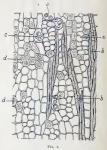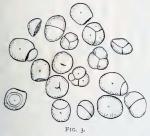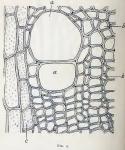This American tree is the only living species of its genus, though the fossil remains from the cretaceous rocks of our Northwest prove that there were once several at least, and probably the genus was once as abundant in species as are now the oaks. This species has probably persisted beyond its congeners by reason of its ability to endure a wide range of conditions. This is evidenced by the fact that it thrives almost equally in the austere climate of Canada and in sub-tropical Florida, and that it endures almost every condition found in the forest regions between these Northern and Southern limits, and between the great plains on the West and the Atlantic coast on the East.
In the North it is a shrub, in middle and southern latitudes it is a tree, often with a trunk that attains a diameter of a foot or more, and a height of fifty or sixty feet. Its top, when growing in open ground, is also dense and shapely, so that the tree is not without value as an ornament to our parks and roadsides. The trunk is covered with a grayish, strongly-fissured bark, but the twigs remain green for several years, the corky layer being slow to form beneath the epidermis.
The alternate exstipulate, petiolate, deciduous leaves are remarkable for the variety of their forms on the same tree. Some are entire, oval and acute or obtuse, while others are more or less deeply separated into two or three unequal lobes, the lateral lobes being the shorter. This variability in the foliage of the tree has given origin to one of its botanical names, that recognized in the last edition of our Pharmacopoeia, namely, Sassafras variifolium. This tree, in fact, well illustrates the vicissitudes of our botanical nomenclature. In the earlier editions of Gray's Manual we find it named Laurus sassafras, following Linnaeus. In the later editions it is called Sassafras officinale, the name given it by Nees. Salisbury named it Laurus variifolius, and now in the recent "List of Pteridophyta and Spermaphyta, growing without cultivation in Northeastern North America," the name Sassafras Sassafras (Linne) Karsten, is adopted, a name doubtless applied in strict accordance with the new rules for botanical nomenclature, but whose unpleasant effect upon the ear could not well be endured except in the hope that sometime between now and the millennium our botanical nomenclature will acquire something like a stable equilibrium.
 The tree is dioecious and the inconspicuous flowers appear in early spring, before or with the leaves. They are arranged in clustered corymb-like racemes which are involucrate with scaly bracts. The sepals, six in number and spreading, are yellowish-green, and in the staminate flowers the nine stamens are inserted in three whorls on the base of the calyx. The stamens of the inner whorl differ from the rest in bearing at the base of each filament a pair of stalked glands, probably representing stipules. The anthers of all the stamens are introrse and have two pairs of loculi, one pair smaller and superposed over the other, and the loculi dehisce by valves.
The tree is dioecious and the inconspicuous flowers appear in early spring, before or with the leaves. They are arranged in clustered corymb-like racemes which are involucrate with scaly bracts. The sepals, six in number and spreading, are yellowish-green, and in the staminate flowers the nine stamens are inserted in three whorls on the base of the calyx. The stamens of the inner whorl differ from the rest in bearing at the base of each filament a pair of stalked glands, probably representing stipules. The anthers of all the stamens are introrse and have two pairs of loculi, one pair smaller and superposed over the other, and the loculi dehisce by valves.
The pistil in the staminate flower is wholly aborted. In the pistillate flower six stamens are present, but with wholly or partly aborted anthers and without pollen. The pistil is single, with an ovoid ovary and a single, rather short style terminated by a discoid stigma. The ovary contains usually a single ovule, which is anatropous and suspended from the top of the ovary.
The fruit is a bluish-black, ovoid drupe of the size of a pea, supported on a fleshy, club-shaped, reddish pedicel, crowned by the persistent reddish calyx teeth, which clasp the fruit at its base. The seed is exalbuminous.
 All parts of the plant contain more or less of volatile oil, but this is much more abundant in the bark of the root, which, therefore, constitutes the most important medicinal portion.
All parts of the plant contain more or less of volatile oil, but this is much more abundant in the bark of the root, which, therefore, constitutes the most important medicinal portion.
The leaves and young twigs, particularly the pith of the latter, are rich in mucilage, which causes them to be employed, to some extent, for demulcent purposes.
A cross-section of the bark of a root which has attained a diameter of two inches or more shows a structure which is represented in the illustration, Fig. 1.
The friable exterior corky layer shows the usual microscopic appearance of corky tissue. The thickish middle bark beneath it is rich in oil cells, which average larger in size than the parenchyma cells among which they are scattered.
Oil cells are not confined to this layer, but occur, though somewhat less abundantly, among the sieve and companion cells of the inner layer of the bark. Parenchyma cells, rich in tannic matters, are also freely scattered through the middle and inner layers.
 The medullary rays, whose course in the bark is usually somewhat wavy, are composed sometimes of one, sometimes of two, and more rarely of three rows of cells.
The medullary rays, whose course in the bark is usually somewhat wavy, are composed sometimes of one, sometimes of two, and more rarely of three rows of cells.
No primary bast fibres are formed in the root bark, and the bark of roots not more than two or three years old is usually destitute of bast fibres of any kind.
Later on, however, secondary bast fibres are formed, but these are never so abundant as to give an evident fibrous fracture to the inner layer of the bark. They are scattered without apparent order through the bast wedges, and are not usually clustered, though occasionally two or three may be seen in juxtaposition.
They are excessively thick-walled, and, for bast fibres, short, their length being not more than from ten to fifteen times their thickness. They are also hard and brittle.
If the bark be gathered in late autumn or in very early spring, the parenchyma cells of the bark, and even the thinnish-walled wood cells and medullary ray cells of the meditullium, are found to be heavily charged with starch grains. These are of rather small size, and, when single, are spherical or spheroidal in shape, with a central hilum, which sometimes shows a few stratification circles about it. The circles, however, are usually indistinct or wanting. The hilum is usually entire, and appears, even under a very high power, as a mere point, but it is sometimes angularly fissured. Compound grains, however, are more common than simple ones, the commonest being double and triple ones, though more complex forms are not uncommon.
In most structural characters the wood of the root and that of the stem resemble each other closely. The ducts, which are mostly of the pitted variety, with the pits closely arranged, are, in both, of large diameter, and usually grouped in twos or threes, but sometimes single. They agree also in the fact that the walls of the wood cells do not become so strongly thickened as they do in many other woody plants, and in the fact that the medullary ray cells are of rather large diameter as compared with the wood cells, are usually elongated in a radial direction, and are finely pitted. They differ chiefly in the conspicuous large-celled pith of the stem, which, of course, does not occur in the root at all, and in the fact that in the stem, the medullary rays are rather more numerous and inclined to become fewer-rowed, three-rowed rays being seldom found.
The differences between the bark of the stem and that of the root are more conspicuous. Besides the inevitable difference due to the presence of chlorophyll in the middle bark of the former and its absence in the latter, and the difference in cork formation already alluded to, namely, the fact of its much more tardy formation in the bark of the stem, the stem-bark contains clusters of numerous primary bast fibres associated with stone cells, which form an interrupted zone at the junction of the middle with the inner bark. Both primary bast fibres and stone cells are wholly wanting in the root-bark. The secondary bast fibres of the stem are similar in structure and arrangement to those of the root.
The volatile oil cells of the stem-bark, while they have a distribution quite similar to that in the root-bark, are very much less abundant.
The American Journal of Pharmacy, Vol. 67, 1895, was edited by Henry Trimble.


